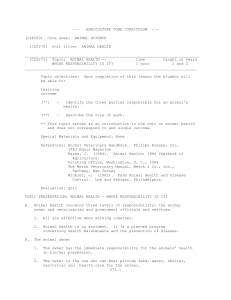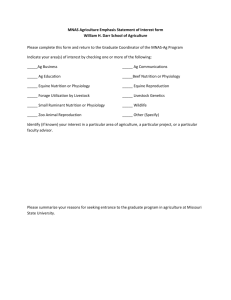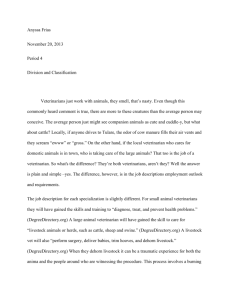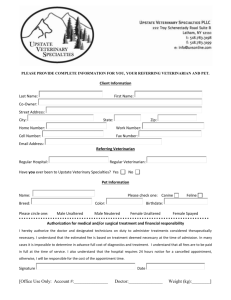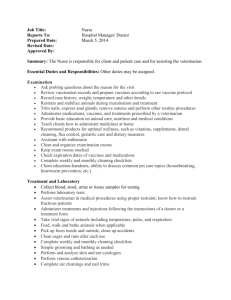Small Ruminants Competency List Ranked In Descending Order by
advertisement
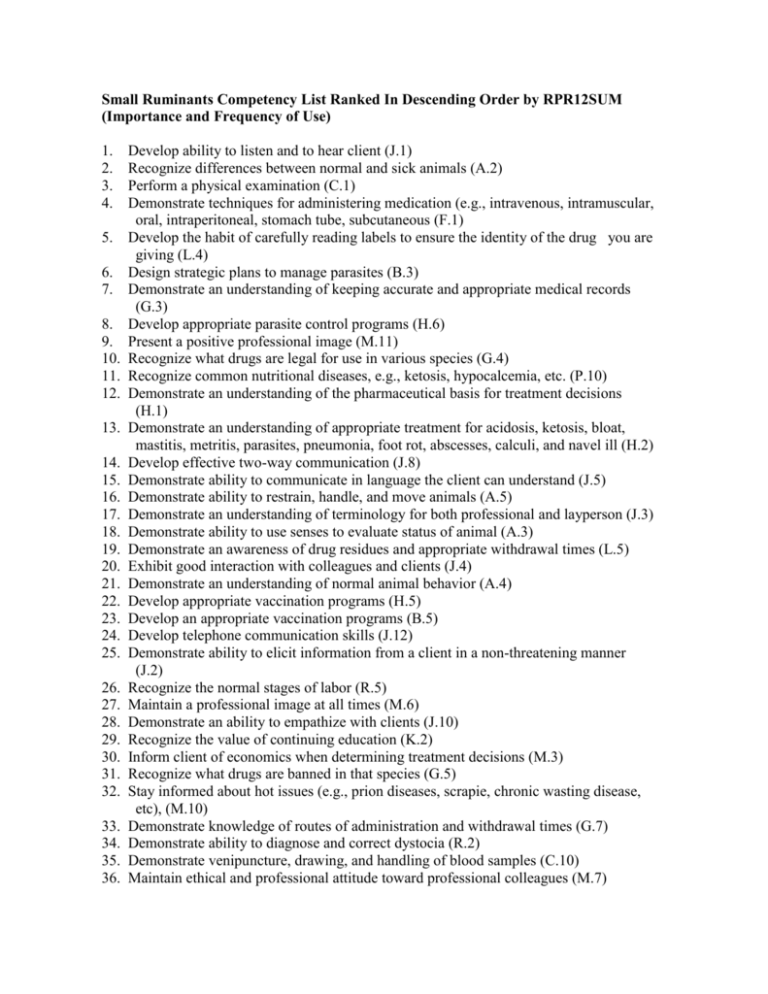
Small Ruminants Competency List Ranked In Descending Order by RPR12SUM (Importance and Frequency of Use) 1. 2. 3. 4. 5. 6. 7. 8. 9. 10. 11. 12. 13. 14. 15. 16. 17. 18. 19. 20. 21. 22. 23. 24. 25. 26. 27. 28. 29. 30. 31. 32. 33. 34. 35. 36. Develop ability to listen and to hear client (J.1) Recognize differences between normal and sick animals (A.2) Perform a physical examination (C.1) Demonstrate techniques for administering medication (e.g., intravenous, intramuscular, oral, intraperitoneal, stomach tube, subcutaneous (F.1) Develop the habit of carefully reading labels to ensure the identity of the drug you are giving (L.4) Design strategic plans to manage parasites (B.3) Demonstrate an understanding of keeping accurate and appropriate medical records (G.3) Develop appropriate parasite control programs (H.6) Present a positive professional image (M.11) Recognize what drugs are legal for use in various species (G.4) Recognize common nutritional diseases, e.g., ketosis, hypocalcemia, etc. (P.10) Demonstrate an understanding of the pharmaceutical basis for treatment decisions (H.1) Demonstrate an understanding of appropriate treatment for acidosis, ketosis, bloat, mastitis, metritis, parasites, pneumonia, foot rot, abscesses, calculi, and navel ill (H.2) Develop effective two-way communication (J.8) Demonstrate ability to communicate in language the client can understand (J.5) Demonstrate ability to restrain, handle, and move animals (A.5) Demonstrate an understanding of terminology for both professional and layperson (J.3) Demonstrate ability to use senses to evaluate status of animal (A.3) Demonstrate an awareness of drug residues and appropriate withdrawal times (L.5) Exhibit good interaction with colleagues and clients (J.4) Demonstrate an understanding of normal animal behavior (A.4) Develop appropriate vaccination programs (H.5) Develop an appropriate vaccination programs (B.5) Develop telephone communication skills (J.12) Demonstrate ability to elicit information from a client in a non-threatening manner (J.2) Recognize the normal stages of labor (R.5) Maintain a professional image at all times (M.6) Demonstrate an ability to empathize with clients (J.10) Recognize the value of continuing education (K.2) Inform client of economics when determining treatment decisions (M.3) Recognize what drugs are banned in that species (G.5) Stay informed about hot issues (e.g., prion diseases, scrapie, chronic wasting disease, etc), (M.10) Demonstrate knowledge of routes of administration and withdrawal times (G.7) Demonstrate ability to diagnose and correct dystocia (R.2) Demonstrate venipuncture, drawing, and handling of blood samples (C.10) Maintain ethical and professional attitude toward professional colleagues (M.7) 37. 38. 39. 40. 41. 42. 43. 44. 45. 46. 47. 48. 49. 50. 51. 52. 53. 54. 55. 56. 57. 58. 59. 60. 61. 62. 63. 64. 65. 66. 67. 68. 69. Perform appropriate restraint (F.3) Demonstrate basic understanding of ruminant physiology (P.8) Demonstrate how to prioritize tasks (I.2) Demonstrate common management techniques (e.g., disbud, castrate, drench, injections, tail dock, and hoof trim), (A.10) Demonstrate obstetrical skills (C.3) Identify what drugs are banned in that species (L.6) Demonstrate an ability to perform a reproduction examination on male and female (R.1) Demonstrate an understanding of appropriate nursing care (F.4) Exhibit a working knowledge of a medical formulary (G.1) Collect fecal samples, perform fecal examination, and interpret results (C.11) Recognize the importance of exactly following state, federal and international animal health regulations (Q.4) Demonstrate knowledge of zoonotic (e.g., abortion diseases, soremouth, ringworm, rabies, tapeworm, tuberculosis, Q fever, Brucellosis, and diarrheal diseases (N.1) Recognize the limitations of your knowledge (J.7) Demonstrate an understanding of the importance of colostrum management (R.10) Demonstrate an understanding of the importance of ethics as related to health certificates (M.5) Recognize effect of route of administration and site selection on carcass quality and economics (L.3) Demonstrate ability and understand value of body condition scoring (P.11) Recognize that nutrient requirements vary with the production cycle (P.5) Perform a necropsy and discuss the herd health impact of the procedure (C.2) Show or explain how to perform the following procedures: dehorning, disbuding, castration, harvesting velvet, tail docking, and corrective foot procedures (E.2) Demonstrate how to appropriately store, handle, and administer vaccines and drugs (H.7) Recognize and be able to treat common neonatal conditions (e.g., hypoglycemia, hypothermia, failure of passive transfer, etc.), (R.8) Demonstrate appropriate computer literacy (I.11) Recognize the value of shared communication among colleagues (K.7) Recognize need to develop species-specific knowledge post-graduation (K.3) Explain the importance of keeping current with professional journals (K.4) Demonstrate appropriate computer literacy (K.8) Recognize the value of shared communication among colleagues (O.6) Demonstrate an understanding of the interrelationship between nutrition and reproduction (R.9) Calculate the cost of a procedure in materials and time (I.1) Demonstrate an understanding of principles of nutrition in sick and convalescent animals (P.4) Demonstrate an understanding for the management and treatment of vaginal and uterine prolapse (R.4) Demonstrate an understanding of appropriate diagnostic tests and methodology for specific conditions (H.10) 70. 71. 72. 73. 74. 75. Describe what equipment is necessary for procedures (L.2) Demonstrate the use of xylazine, ketamine, and lidocaine (D.2) Demonstrate knowledge of normal physiologic parameters (C.4) Demonstrate ability to interpret the validity of data (K.5) Demonstrate an understanding of applied (practical) nutrition (A.7) Recognize the value of professional organizations as collector and disseminator of information (O.3) 76. Demonstrate an understanding of common feedstuffs (P.9) 77. Perform rectal, vaginal and uterine prolapse repair (E.4) 78. Exhibit ability to convince a client of the value of recommended services (I.3) 79. Describe proper post-surgical care (E.6) 80. Demonstrate an understanding of the importance of being federally accredited veterinarian for small ruminant practice (Q.1) 81. Identify how to motivate employees and be a self-starter (J.9) 82. Demonstrate awareness that adverse drug reactions can occur when mixing drugs in same syringe or animal (G.8) 83. Recognize the importance of effective client communication relative to nutrition (P.6) 84. Discuss control program for chronic diseases (e.g., progressive pneumonia, Caprine Arthritis-Encephalitis, Johne’s, Caseous Lymphadenitis, etc. (H.8) 85. Perform a surgical prep (E.7) 86. Demonstrate how to use Animal Medicinal Drug Use Clarification Act guidelines for extra-label use of drugs (G.6) 87. Demonstrate an understanding of nutrient imbalances and interactions and their treatment (e.g., Cu, Se, etc.), (H.3) 88. Demonstrate an understanding that regulations vary by species, state, and time (Q.3) 89. Demonstrate an understanding of the ethics of pharmaceutical use and the Animal Medicinal Drugs Use Clarification Act guidelines (M.9) 90. Demonstrate ability to diagnose and treat infertility and abortion (R.7) 91. Demonstrate an understanding of basis for setting “just” fees for profitable practice (I.5) 92. Recognize the importance of a veterinarian’s role in reportable diseases (Q.5) 93. Perform appropriate intravenous treatments (F.2) 94. Demonstrate an ability to access and utilize information, e.g., internet, library, human resources (K.6) 95. Demonstrate an understanding of the interaction of nutrition and immunology (P.2) 96. Recognize issues regarding reportable diseases (M.4) 97. Recognize the need to be able to communicate with other professionals in allied fields (e.g., nutrition), (M.12) 98. Develop a plan for repaying student loans (I.7) 99. Evaluate the status of a flock or herd in the environment (A.6) 100. Demonstrate an understanding of biosecurity and its role in disease control (B.7 101. Demonstrate an understanding of prion diseases and develop a plan to educate flock owners regarding risk (B.9) 102. Develop plans to investigate and manage disease outbreaks (B.11) 103. Describe practice-building skills and endeavors (I.8) 104. Demonstrate ability to treat retained placenta with species-appropriate therapy (R.11) 105. Evaluate procedure with overwhelming concern for quality of life of the animal (M.2) 106. Recognize the relative nutrient values of feedstuffs and forages (P.7) 107. Demonstrate an understanding of the limits of pharmaceutical choices available in practice (I.6) 108. Perform pregnancy evaluation (C.12) 109. Recognize the veterinarian’s important role in animal welfare issues (M.13) 110. Recognize that the veterinarian is a community expert on zoonotic diseases (N.4) 111. Interpret laboratory data and demonstrate an understanding of differences between laboratories (H.9) 112. Recognize the value of local, state, and national veterinary organizations (O.5) 113. Demonstrate an understanding of regional diseases (H.11) 114. Develop plans to investigate and manage different flock problems (B.10) 115. Discuss criteria for culling (C.8) 116. Describe small ruminant idiosyncrasies to anesthetic agents (D.1) 117. Recognize that quality assurance issues are related to public health (N.6) 118. Recognize forages, forbs, and poisonous plants (P.1) 119. Recognize the importance of rabies as a public health risk (N.3) 120. Recognize the importance of a veterinarian’s role in enforcing Food and Drug Administration regulations (Q.6) 121. Perform a cesarean under field conditions (E.3) 122. Recognize that diagnostic labs vary in resources, services, and quality (L.11) 123. Recognize the greater power of a group or organization to effect change (O.4) 124. Treat retained placenta with species appropriate treatment (H.4) 125. Demonstrate ability to find appropriate state and federal animal health officials (Q.7) 126. Recognize the value of professional organizations in networking (O.2) 127. Demonstrate an understanding of the necessity of educating youth livestock exhibitors (L.9) 128. Recognize the importance of a farm visit for communicating nutrient requirements (P.12) 129. Demonstrate an understanding of population dynamics and immune response (B.4) 130. Discuss the diversity between the business and medical side of practice (I.4) 131. Demonstrate an understanding of production cycles as they relate to the calendar (A.9) 132. Demonstrate an understanding of the ethics of showing livestock (M.8) 133. Perform surgical treatment for urinary calculi (E.5) 134. Demonstrate ability to remove milk from udder (C.7) 135. Demonstrate how to prepare surgical packs (L.1) 136. Demonstrate an understanding of uniform animal identification (L.8) 137. Explain the benefits of staying current with the lay press related to your species of interest (A.12) 138. Recognize the need to communicate with nutritionists (P.3) 139. Discuss importance of regular reading of the popular press related to species (K.1) 140. Explain the types of insurance needed for a practice (I.9) 141. Demonstrate awareness of various state regulations regarding prohibited species (Q.2) 142. Perform intramammary infusion (F.5) 143. Recognize the value of professional organizations in building collegiality (O.1) 144. Develop and evaluate the adequacy of appropriate herd records (B.1) 145. Demonstrate an understanding of principles of salesmanship for products and services (I.10) 146. Describe the variety of normal production systems for the classes of livestock within each species (A.1) 147. Name legal and safe methods of carcass disposal (D.5) 148. Evaluate the factors that determine the safety of an environment for humans and animals (A.13) 149. Demonstrate the indications for and ability to perform a fetotomy (R.3) 150. Demonstrate ability to educate clients on proper dead animal disposal (N.2) 151. Evaluate herd records (B.2) 152. Develop public speaking ability (J.11) 153. Demonstrate an understanding of Hazard Analysis and Critical Control Point principles (L.7) 154. Demonstrate an understanding of the ethical issues related to surgical techniques (M.1) 155. Demonstrate an understanding of the economics of the small ruminant industry (A.11) 156. Demonstrate an understanding of how to interact with media (J.6) 157. Demonstrate a working knowledge of an ultrasound machine (C.6) 158. Recognize normal dentition and age animals by dental examination (C.9) 159. Identify issues related to animal welfare and euthanasia (D.4) 160. Demonstrate how to exteriorize a penis (C.5) 161. Recognize and demonstrate how to report adverse drug reactions (G.2) 162. Operate, clean, and assemble an automatic syringe (F.6) 163. Demonstrate understanding of equipment used in producing milk (L.10) 164. Demonstrate an understanding of least cost ration formulation (P.13) 165. Discuss American Veterinary Medical Association approved euthanasia methods (D.3) 166. Explain the ethical issues related to surgical techniques (E.1) 167. Discuss issues associated with and methods of predator control (B.8) 168. Discuss transportation issues (e.g., truck exhaust, animal density, transport tetany, weather, animal welfare, and laws), (B.6) 169. Recognize common congenital defects (A.8) 170. Recognize your obligation to inform clients about environmental impact of livestock production (N.5) 171. Demonstrate understanding and be able to perform artificial insemination and estrus synchronization (R.6)
